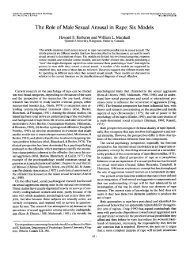Regulation of the dopamine transporter - Addiction Research ...
Regulation of the dopamine transporter - Addiction Research ...
Regulation of the dopamine transporter - Addiction Research ...
You also want an ePaper? Increase the reach of your titles
YUMPU automatically turns print PDFs into web optimized ePapers that Google loves.
Schmitt & Reith DAT <strong>Regulation</strong><br />
around 1 min, before quickly dropping back to baseline<br />
levels within 3 min. In accordance with most<br />
substrate-induced trafficking studies, DAT surface<br />
expression began to drop below vehicle levels<br />
after 20 min <strong>of</strong> amphetamine exposure. Curiously,<br />
<strong>dopamine</strong> itself was not found to induce <strong>the</strong> same<br />
immediate upregulation <strong>of</strong> surface DAT expression<br />
as amphetamine, indicating that this biphasic<br />
trafficking pattern might not extend to all DAT<br />
substrates and may contribute to amphetamine’s<br />
ability to stimulate <strong>dopamine</strong> efflux via <strong>the</strong> DAT. 31<br />
However, a more recent study from this group—<br />
using total internal reflection fluorescent microscopy<br />
to visualize hDAT trafficking dynamics in<br />
N2Aneuroblastomacellswithreal-timetemporal<br />
resolution—shows evidence that both <strong>dopamine</strong><br />
(10 �M) and d-amphetamine (5 �M) induce<br />
changes in surface DAT expression within seconds,<br />
but <strong>the</strong> effect <strong>of</strong> amphetamine persisted longer after<br />
substrate washout. 32<br />
Effects <strong>of</strong> DAT inhibitors<br />
Compared with <strong>the</strong> robust literature on DAT regulation<br />
by phenethylamine substrates, <strong>the</strong>re is a paucity<br />
<strong>of</strong> studies investigating <strong>the</strong> acute regulatory effects<br />
<strong>of</strong> DAT inhibitors. The few in vitro regulatory studies<br />
using heterologous cell systems, as well as <strong>the</strong> bulk<br />
<strong>of</strong> in vivo and clinical studies, have focused solely<br />
on <strong>the</strong> classical DAT inhibitor cocaine, doubtless a<br />
result <strong>of</strong> its notorious reputation as one <strong>of</strong> <strong>the</strong> most<br />
addictive compounds known to humans. 33 Atypical<br />
DAT inhibitors lacking cocaine-like abuse potential<br />
34,35 remain almost entirely uninvestigated;<br />
thus, it is not yet possible to make global statements<br />
regarding <strong>the</strong> regulatory effects <strong>of</strong> inhibitors<br />
o<strong>the</strong>r than cocaine. However, at least for cocaine,<br />
it appears that nontranslocated DAT inhibitors not<br />
only block <strong>the</strong> acute regulatory effects <strong>of</strong> substrates,<br />
<strong>the</strong>y may exert <strong>the</strong> opposite effect: insertion <strong>of</strong> DATs<br />
from <strong>the</strong> endosomic recycling pool into <strong>the</strong> plasma<br />
membrane. 16,36<br />
Chronic administration <strong>of</strong> cocaine upregulates<br />
striatal DAT expression in rhesus monkeys, an<br />
effect that persists for more than 30 days after<br />
cocaine withdrawal. 37 Increased DAT expression<br />
has also been shown in postmortem analyses <strong>of</strong><br />
brain tissue from human cocaine addicts 38 and<br />
synaptosomes prepared from this tissue exhibit<br />
greater [ 3 H]<strong>dopamine</strong> uptake than synaptosomes<br />
from age-matched cocaine-naïve individuals. 39 In<br />
addition, cyclic voltammetry studies <strong>of</strong> rats that<br />
exhibit a self-administration preference for high<br />
doses <strong>of</strong> cocaine reveal a specific increase in <strong>the</strong><br />
V max <strong>of</strong> <strong>dopamine</strong> uptake with no effect on <strong>the</strong><br />
Km for <strong>dopamine</strong>, suggesting an upregulation <strong>of</strong><br />
DAT expression. 40 Interestingly, <strong>the</strong>se results are<br />
exactly inverted compared with <strong>the</strong> findings for<br />
d-methamphetamine, indicating that <strong>the</strong> two psychostimulants<br />
possess opposing effects on DAT trafficking,<br />
despite <strong>the</strong>ir comparably high abuse potentials.<br />
Different effects on plasmalemmal DAT<br />
expression may play a role in <strong>the</strong> observed efficacy<br />
<strong>of</strong> d-amphetamine for <strong>the</strong> treatment <strong>of</strong> cocaine<br />
dependence in preclinical and early clinical<br />
trials. 41–44<br />
In studies <strong>of</strong> hDAT-expressing cultured cells,<br />
preincubation with cocaine has been routinely<br />
demonstrated to prevent <strong>the</strong> DAT-internalizing effects<br />
<strong>of</strong> substrates (e.g., Refs. 23, 24, and 45), as well<br />
as <strong>the</strong> putative amphetamine-induced brief, transient<br />
upregulation <strong>of</strong> surface DAT levels. 31,32 The<br />
acute effects <strong>of</strong> cocaine on DAT trafficking in <strong>the</strong><br />
absence <strong>of</strong> substrates are less consistent: whereas<br />
some research groups have shown that cocaine elicits<br />
a rapid increase in plasmalemmal DAT expression,<br />
46,47 o<strong>the</strong>rs have found no effect <strong>of</strong> cocaine pretreatment<br />
on DAT activity or surface expression. 24,48<br />
In <strong>the</strong> study by Little et al., treatment <strong>of</strong> N2A-hDAT<br />
cells with 1 �M cocaine for 24 h increased cell<br />
surface DAT expression by approximately 30%. 47<br />
Remarkably, this same magnitude <strong>of</strong> increase was<br />
detected using a wide array <strong>of</strong> techniques, including<br />
biotinylation, intact-cell [ 3 H]CFT binding, and<br />
visualization <strong>of</strong> plasma membrane anti-DAT immun<strong>of</strong>luorescence<br />
with confocal microscopy. 47 The<br />
long incubation time used in this study (24 h) may<br />
underlie some <strong>of</strong> <strong>the</strong> discrepancy with o<strong>the</strong>r reports<br />
showing no effect <strong>of</strong> cocaine, because most studies<br />
have used incubation times on <strong>the</strong> order <strong>of</strong> 30 min to<br />
1 h—curiously, however, Daws et al.demonstrateda<br />
cocaine-mediated increase in surface expressed DAT<br />
in HEK-hDAT cells after only 1 h <strong>of</strong> treatment. 46<br />
Cellular signaling cascades,<br />
phosphorylation, and DAT regulation<br />
DAT phosphorylation and trafficking<br />
Members <strong>of</strong> <strong>the</strong> neurotransmitter sodium symporter<br />
superfamily are large proteins—<strong>the</strong> hDAT<br />
possesses 620 amino acid residues—containing<br />
Ann. N.Y. Acad. Sci. 1187 (2010) 316–340 c○ 2010 New York Academy <strong>of</strong> Sciences. 321










